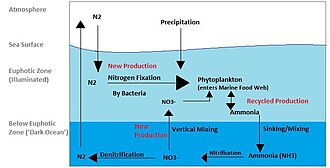Bacterioplankton



File:Lake Ontario food web.pdf

Bacterioplankton are a component of the plankton that drifts in the water column of oceans, seas, and bodies of fresh water. They are a heterogeneous group of microscopic organisms, primarily consisting of bacteria and archaea, which play a crucial role in the aquatic ecosystem. Bacterioplankton are involved in various critical processes such as biogeochemical cycles, including the carbon, nitrogen, and sulfur cycles, making them essential for maintaining the health of aquatic environments.
Characteristics[edit]
Bacterioplankton vary in shape, size, and function. Unlike larger planktonic organisms, they are not easily seen without the aid of a microscope. These organisms are incredibly diverse, with species adapted to a wide range of environmental conditions, from the sunlit surface waters to the dark depths of the oceans and freshwater systems.
Ecological Role[edit]
The primary role of bacterioplankton is in the decomposition of organic matter. They break down dead phytoplankton, zooplankton, and other organic materials, recycling nutrients back into the ecosystem. This process is vital for the regeneration of nutrients and supports the growth of other aquatic organisms. Bacterioplankton also contribute to the primary production in aquatic environments through photosynthesis and chemosynthesis, particularly in areas where light penetration is low, and other forms of primary production are limited.
In addition to their role in nutrient cycling, bacterioplankton are a key food source for other microscopic organisms, such as protozoa and small zooplankton, linking the microbial loop with the larger food web. This connection underscores the importance of bacterioplankton in supporting aquatic food webs and maintaining the productivity of aquatic environments.
Research and Importance[edit]
Research on bacterioplankton has increased with advances in molecular biology techniques, allowing scientists to explore the diversity, distribution, and functional roles of these organisms in greater detail. Studies have shown that changes in bacterioplankton communities can significantly affect nutrient cycling, water quality, and the overall health of aquatic ecosystems. Understanding the dynamics of bacterioplankton populations is also crucial for monitoring the effects of environmental changes, such as climate change, pollution, and eutrophication, on aquatic ecosystems.
Challenges[edit]
One of the main challenges in studying bacterioplankton is their immense diversity and the complexity of their interactions with other organisms and the environment. Additionally, the impact of human activities on bacterioplankton communities and their ecological functions is not fully understood, making the conservation and management of aquatic ecosystems more challenging.
Conclusion[edit]
Bacterioplankton are a vital component of aquatic ecosystems, playing essential roles in nutrient cycling, energy flow, and supporting biodiversity. Continued research on these microscopic organisms is crucial for understanding their ecological functions and the impacts of environmental changes on aquatic ecosystems.
Ad. Transform your life with W8MD's Budget GLP-1 injections from $75


W8MD offers a medical weight loss program to lose weight in Philadelphia. Our physician-supervised medical weight loss provides:
- Weight loss injections in NYC (generic and brand names):
- Zepbound / Mounjaro, Wegovy / Ozempic, Saxenda
- Most insurances accepted or discounted self-pay rates. We will obtain insurance prior authorizations if needed.
- Generic GLP1 weight loss injections from $75 for the starting dose.
- Also offer prescription weight loss medications including Phentermine, Qsymia, Diethylpropion, Contrave etc.
NYC weight loss doctor appointmentsNYC weight loss doctor appointments
Start your NYC weight loss journey today at our NYC medical weight loss and Philadelphia medical weight loss clinics.
- Call 718-946-5500 to lose weight in NYC or for medical weight loss in Philadelphia 215-676-2334.
- Tags:NYC medical weight loss, Philadelphia lose weight Zepbound NYC, Budget GLP1 weight loss injections, Wegovy Philadelphia, Wegovy NYC, Philadelphia medical weight loss, Brookly weight loss and Wegovy NYC
|
WikiMD's Wellness Encyclopedia |
| Let Food Be Thy Medicine Medicine Thy Food - Hippocrates |
Medical Disclaimer: WikiMD is not a substitute for professional medical advice. The information on WikiMD is provided as an information resource only, may be incorrect, outdated or misleading, and is not to be used or relied on for any diagnostic or treatment purposes. Please consult your health care provider before making any healthcare decisions or for guidance about a specific medical condition. WikiMD expressly disclaims responsibility, and shall have no liability, for any damages, loss, injury, or liability whatsoever suffered as a result of your reliance on the information contained in this site. By visiting this site you agree to the foregoing terms and conditions, which may from time to time be changed or supplemented by WikiMD. If you do not agree to the foregoing terms and conditions, you should not enter or use this site. See full disclaimer.
Credits:Most images are courtesy of Wikimedia commons, and templates, categories Wikipedia, licensed under CC BY SA or similar.
Translate this page: - East Asian
中文,
日本,
한국어,
South Asian
हिन्दी,
தமிழ்,
తెలుగు,
Urdu,
ಕನ್ನಡ,
Southeast Asian
Indonesian,
Vietnamese,
Thai,
မြန်မာဘာသာ,
বাংলা
European
español,
Deutsch,
français,
Greek,
português do Brasil,
polski,
română,
русский,
Nederlands,
norsk,
svenska,
suomi,
Italian
Middle Eastern & African
عربى,
Turkish,
Persian,
Hebrew,
Afrikaans,
isiZulu,
Kiswahili,
Other
Bulgarian,
Hungarian,
Czech,
Swedish,
മലയാളം,
मराठी,
ਪੰਜਾਬੀ,
ગુજરાતી,
Portuguese,
Ukrainian


